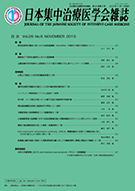Volume 26, Issue 6
Displaying 1-15 of 15 articles from this issue
- |<
- <
- 1
- >
- >|
-
2019Volume 26Issue 6 Pages 421
Published: November 01, 2019
Released on J-STAGE: November 01, 2019
Download PDF (126K)
REVIEW ARTICLE
-
2019Volume 26Issue 6 Pages 423-429
Published: November 01, 2019
Released on J-STAGE: November 01, 2019
Download PDF (417K)
ORIGINAL ARTICLES
-
2019Volume 26Issue 6 Pages 431-437
Published: November 01, 2019
Released on J-STAGE: November 01, 2019
Download PDF (443K) -
2019Volume 26Issue 6 Pages 438-444
Published: November 01, 2019
Released on J-STAGE: November 01, 2019
Download PDF (321K)
CASE REPORT
-
2019Volume 26Issue 6 Pages 445-448
Published: November 01, 2019
Released on J-STAGE: November 01, 2019
Download PDF (761K)
BRIEF REPORTS
-
2019Volume 26Issue 6 Pages 449-450
Published: November 01, 2019
Released on J-STAGE: November 01, 2019
Download PDF (271K) -
2019Volume 26Issue 6 Pages 451-452
Published: November 01, 2019
Released on J-STAGE: November 01, 2019
Download PDF (251K) -
2019Volume 26Issue 6 Pages 453-454
Published: November 01, 2019
Released on J-STAGE: November 01, 2019
Download PDF (168K) -
2019Volume 26Issue 6 Pages 455-456
Published: November 01, 2019
Released on J-STAGE: November 01, 2019
Download PDF (208K) -
2019Volume 26Issue 6 Pages 457-458
Published: November 01, 2019
Released on J-STAGE: November 01, 2019
Download PDF (224K) -
2019Volume 26Issue 6 Pages 459-460
Published: November 01, 2019
Released on J-STAGE: November 01, 2019
Download PDF (183K) -
2019Volume 26Issue 6 Pages 461-462
Published: November 01, 2019
Released on J-STAGE: November 01, 2019
Download PDF (266K) -
2019Volume 26Issue 6 Pages 463-464
Published: November 01, 2019
Released on J-STAGE: November 01, 2019
Download PDF (318K) -
2019Volume 26Issue 6 Pages 465-466
Published: November 01, 2019
Released on J-STAGE: November 01, 2019
Download PDF (261K)
COMMITTEE REPORT
-
2019Volume 26Issue 6 Pages 467-475
Published: November 01, 2019
Released on J-STAGE: November 01, 2019
Download PDF (763K)
- |<
- <
- 1
- >
- >|
